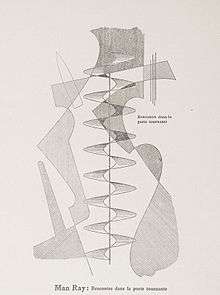Dada

Dada (/ˈdɑːdɑː/) or Dadaism was an art movement of the European avant-garde in the early 20th century. Dada in Zürich, Switzerland, began in 1916 at Cabaret Voltaire, spreading to Berlin shortly thereafter, but the height of New York Dada was the year before, in 1915.[1] The term anti-art, a precursor to Dada, was coined by Marcel Duchamp around 1913 when he created his first readymades.[2] Dada, in addition to being anti-war, had political affinities with the radical left and was also anti-bourgeois.[3]

At least two works qualified as pre-Dadaist, a posteriori, had already sensitized the public and artists alike: Ubu Roi (1896) by Alfred Jarry, and the ballet Parade (1916–17) by Erik Satie.[4] The roots of Dada lay in pre-war avant-garde. Cubism and the development of collage, combined with Wassily Kandinsky's theoretical writings and abstraction, detached the movement from the constraints of reality and convention. The influence of French poets and the writings of German Expressionists liberated Dada from the tight correlation between words and meaning.[5] Avant-garde circles outside France knew of pre-war Parisian developments. They had seen (or participated in) Cubist exhibitions held at Galería Dalmau, Barcelona (1912), Galerie Der Sturm in Berlin (1912), the Armory show in New York (1913), SVU Mánes in Prague (1914), several Jack of Diamonds exhibitions in Moscow and at De Moderne Kunstkring, Amsterdam (between 1911 and 1915). Futurism developed in response to the work of various artists. Dada subsequently combined these approaches.[6]
Dada activities included public gatherings, demonstrations, and publication of art/literary journals; passionate coverage of art, politics, and culture were topics often discussed in a variety of media. Key figures in the movement included Hugo Ball, Emmy Hennings, Hans Arp, Raoul Hausmann, Hannah Höch, Johannes Baader, Tristan Tzara, Francis Picabia, Richard Huelsenbeck, George Grosz, John Heartfield, Marcel Duchamp, Man Ray, Beatrice Wood, Kurt Schwitters, Hans Richter, and Max Ernst, among others. The movement influenced later styles like the avant-garde and downtown music movements, and groups including surrealism, Nouveau Réalisme, pop art and Fluxus.
Overview

Dada was an informal international movement, with participants in Europe and North America. The beginnings of Dada correspond to the outbreak of World War I. For many participants, the movement was a protest against the bourgeois nationalist and colonialist interests, which many Dadaists believed were the root cause of the war, and against the cultural and intellectual conformity—in art and more broadly in society—that corresponded to the war.[7]
Many Dadaists believed that the 'reason' and 'logic' of bourgeois capitalist society had led people into war. They expressed their rejection of that ideology in artistic expression that appeared to reject logic and embrace chaos and irrationality.[8][9] For example, George Grosz later recalled that his Dadaist art was intended as a protest "against this world of mutual destruction."[8]
According to Hans Richter Dada was not art: it was "anti-art."[7] Dada represented the opposite of everything which art stood for. Where art was concerned with traditional aesthetics, Dada ignored aesthetics. If art was to appeal to sensibilities, Dada was intended to offend.
As Hugo Ball expressed it, "For us, art is not an end in itself ... but it is an opportunity for the true perception and criticism of the times we live in."[10]
A reviewer from the American Art News stated at the time that "Dada philosophy is the sickest, most paralyzing and most destructive thing that has ever originated from the brain of man." Art historians have described Dada as being, in large part, a "reaction to what many of these artists saw as nothing more than an insane spectacle of collective homicide."[11]
Years later, Dada artists described the movement as "a phenomenon bursting forth in the midst of the postwar economic and moral crisis, a savior, a monster, which would lay waste to everything in its path... [It was] a systematic work of destruction and demoralization... In the end it became nothing but an act of sacrilege."[11]
To quote Dona Budd's The Language of Art Knowledge,
Dada was born out of negative reaction to the horrors of the First World War. This international movement was begun by a group of artists and poets associated with the Cabaret Voltaire in Zürich. Dada rejected reason and logic, prizing nonsense, irrationality and intuition. The origin of the name Dada is unclear; some believe that it is a nonsensical word. Others maintain that it originates from the Romanian artists Tristan Tzara's and Marcel Janco's frequent use of the words "da, da," meaning "yes, yes" in the Romanian language. Another theory says that the name "Dada" came during a meeting of the group when a paper knife stuck into a French–German dictionary happened to point to 'dada', a French word for 'hobbyhorse'.[9]
The movement primarily involved visual arts, literature, poetry, art manifestos, art theory, theatre, and graphic design, and concentrated its anti-war politics through a rejection of the prevailing standards in art through anti-art cultural works.
History
Zürich

In 1916, Hugo Ball, Emmy Hennings, Tristan Tzara, Jean Arp, Marcel Janco, Richard Huelsenbeck, Sophie Taeuber, and Hans Richter, along with others, discussed art and put on performances in the Cabaret Voltaire expressing their disgust with the war and the interests that inspired it.
Some sources state that Dada coalesced on October 6 at the Cabaret Voltaire. Other sources state that Dada did not originate fully in a Zürich literary salon but grew out of an already vibrant artistic tradition in Eastern Europe, particularly Romania, that transposed to Switzerland when a group of Jewish modernist artists (Tzara, Janco, Arthur Segal, and others) settled in Zürich. In the years prior to the First World War similar art had already risen in Bucharest and other Eastern European cities; it is likely that Dada's catalyst was the arrival in Zürich of artists like Tzara and Janco.[12]
Having left Germany and Romania during the Great War, the artists found themselves in Switzerland, a country recognized for its neutrality. Inside this space of political neutrality they decided to use abstraction to fight against the social, political, and cultural ideas of that time. The dadaists believed those ideas to be a byproduct of bourgeois society, a society so apathetic it would rather fight a war against itself than challenge the status quo.[13]
Janco recalled, "We had lost confidence in our culture. Everything had to be demolished. We would begin again after the tabula rasa. At the Cabaret Voltaire we began by shocking common sense, public opinion, education, institutions, museums, good taste, in short, the whole prevailing order." [14]
The Cabaret closed its doors in early July and then at the first public soiree at Waag Hall[15] on July 14, 1916, Ball recited the first manifesto. In 1917, Tzara wrote a second Dada manifesto considered one of the most important Dada writings, which was published in 1918. Other manifestos followed.
A single issue of the magazine Cabaret Voltaire was the first publication to come out of the movement.
After the cabaret closed down, Dada activities moved on to a new gallery, and Hugo Ball left for Bern. Tzara began a relentless campaign to spread Dada ideas. He bombarded French and Italian artists and writers with letters, and soon emerged as the Dada leader and master strategist. The Cabaret Voltaire re-opened, and is still in the same place at the Spiegelgasse 1 in the Niederdorf.
Zürich Dada, with Tzara at the helm, published the art and literature review Dada beginning in July 1917, with five editions from Zürich and the final two from Paris.
Other artists, such as André Breton and Philippe Soupault, created “literature groups to help extend the influence of Dada.”[16]
After the fighting of the First World War had ended in the armistice of November 1918, most of the Zürich Dadaists returned to their home countries, and some began Dada activities in other cities. Others, such as the Swiss native Sophie Taeuber, would remain in Zürich into the 1920s.
Berlin

"Berlin was a city of tightened stomachers, of mounting, thundering hunger, where hidden rage was transformed into a boundless money lust, and men's minds were concentrating more and more on questions of naked existence... Fear was in everybody's bones "- Richard Hülsenbeck
The groups in Germany were not as strongly anti-art as other groups. Their activity and art were more political and social, with corrosive manifestos and propaganda, satire, public demonstrations and overt political activities. The intensely political and war-torn environment of Berlin had a dramatic impact on the ideas of Berlin Dadaists. Conversely, New York's geographic distance from the war spawned its more theoretically-driven, less political nature.[17]
In February 1918, while the Great War was approaching its climax, Huelsenbeck gave his first Dada speech in Berlin, and he produced a Dada manifesto later in the year. Following the October Revolution in Russia, by then out of the war, Hannah Höch and George Grosz used Dada to express communist sympathies. Grosz, together with John Heartfield, Höch and Hausmann developed the technique of photomontage during this period. After the war, the artists published a series of short-lived political magazines and held the First International Dada Fair, 'the greatest project yet conceived by the Berlin Dadaists', in the summer of 1920.[18] As well as work by the main members of Berlin Dada – Grosz, Raoul Hausmann, Hannah Höch, Johannes Baader, Huelsenbeck and Heartfield – the exhibition also included the work of Otto Dix, Francis Picabia, Jean Arp, Max Ernst, Rudolf Schlichter, Johannes Baargeld and others.[18] In all, over 200 works were exhibited, surrounded by incendiary slogans, some of which also ended up written on the walls of the Nazi's Entartete Kunst exhibition in 1937. Despite high ticket prices, the exhibition lost money, with only one recorded sale.[19]
The Berlin group published periodicals such as Club Dada, Der Dada, Everyman His Own Football, and Dada Almanach.
Cologne
In Cologne, Ernst, Baargeld, and Arp launched a controversial Dada exhibition in 1920 which focused on nonsense and anti-bourgeois sentiments. Cologne's Early Spring Exhibition was set up in a pub, and required that participants walk past urinals while being read lewd poetry by a woman in a communion dress. The police closed the exhibition on grounds of obscenity, but it was re-opened when the charges were dropped.[20]

New York
Like Zürich, New York City was a refuge for writers and artists from the First World War. Soon after arriving from France in 1915, Marcel Duchamp and Francis Picabia met American artist Man Ray. By 1916 the three of them became the center of radical anti-art activities in the United States. American Beatrice Wood, who had been studying in France, soon joined them, along with Elsa von Freytag-Loringhoven. Arthur Cravan, fleeing conscription in France, was also present for a time. Much of their activity centered in Alfred Stieglitz's gallery, 291, and the home of Walter and Louise Arensberg.
The New Yorkers, though not particularly organized, called their activities Dada, but they did not issue manifestos. They issued challenges to art and culture through publications such as The Blind Man, Rongwrong, and New York Dada in which they criticized the traditionalist basis for museum art. New York Dada lacked the disillusionment of European Dada and was instead driven by a sense of irony and humor. In his book Adventures in the arts: informal chapters on painters, vaudeville and poets Marsden Hartley included an essay on "The Importance of Being 'Dada'".

During this time Duchamp began exhibiting "readymades" (everyday objects found or purchased and declared art) such as a bottle rack, and was active in the Society of Independent Artists. In 1917 he submitted the now famous Fountain, a urinal signed R. Mutt, to the Society of Independent Artists exhibition only to have the piece rejected. First an object of scorn within the arts community, the Fountain has since become almost canonized by some as one of the most recognizable modernist works of sculpture. Art world experts polled by the sponsors of the 2004 Turner Prize, Gordon's gin, voted it "the most influential work of modern art." [21] [22] As recent scholarship documents, the work is likely more collaborative than it has been given credit for in twentieth-century art history. Duchamp indicates in a 1917 letter to his sister that a female friend was centrally involved in the conception of this work. As he writes: "One of my female friends who had adopted the pseudonym Richard Mutt sent me a porcelain urinal as a sculpture."[23] The piece is more in line with the scatological aesthetics of Duchamp's friend and neighbour, the Baroness Elsa von Freytag-Loringhoven, than Duchamp's.[24] In an attempt to "pay homage to the spirit of Dada" a performance artist named Pierre Pinoncelli made a crack in The Fountain with a hammer in January 2006; he also urinated on it in 1993.
Picabia's travels tied New York, Zürich and Paris groups together during the Dadaist period. For seven years he also published the Dada periodical 391 in Barcelona, New York City, Zürich, and Paris from 1917 through 1924.
By 1921, most of the original players moved to Paris where Dada experienced its last major incarnation.
Paris

The French avant-garde kept abreast of Dada activities in Zürich with regular communications from Tristan Tzara (whose pseudonym means "sad in country," a name chosen to protest the treatment of Jews in his native Romania), who exchanged letters, poems, and magazines with Guillaume Apollinaire, André Breton, Max Jacob, Clément Pansaers, and other French writers, critics and artists.
Paris had arguably been the classical music capital of the world since the advent of musical Impressionism in the late 19th century. One of its practitioners, Erik Satie, collaborated with Picasso and Cocteau in a mad, scandalous ballet called Parade. First performed by the Ballets Russes in 1917, it succeeded in creating a scandal but in a different way than Stravinsky's Le Sacre du Printemps had done almost five years earlier. This was a ballet that was clearly parodying itself, something traditional ballet patrons would obviously have serious issues with.
Dada in Paris surged in 1920 when many of the originators converged there. Inspired by Tzara, Paris Dada soon issued manifestos, organized demonstrations, staged performances and produced a number of journals (the final two editions of Dada, Le Cannibale, and Littérature featured Dada in several editions.)[25]
The first introduction of Dada artwork to the Parisian public was at the Salon des Indépendants in 1921. Jean Crotti exhibited works associated with Dada including a work entitled, Explicatif bearing the word Tabu. In the same year Tzara staged his Dadaist play The Gas Heart to howls of derision from the audience. When it was re-staged in 1923 in a more professional production, the play provoked a theatre riot (initiated by André Breton) that heralded the split within the movement that was to produce Surrealism. Tzara's last attempt at a Dadaist drama was his "ironic tragedy" Handkerchief of Clouds in 1924.
Netherlands
In the Netherlands the Dada movement centered mainly around Theo van Doesburg, best known for establishing the De Stijl movement and magazine of the same name. Van Doesburg mainly focused on poetry, and included poems from many well-known Dada writers in De Stijl such as Hugo Ball, Hans Arp and Kurt Schwitters. Van Doesburg and Thijs Rinsema (a cordwainer in Drachten) became friends of Schwitters, and together they organized the so-called Dutch Dada campaign in 1923, where Van Doesburg promoted a leaflet about Dada (entitled What is Dada?), Schwitters read his poems, Vilmos Huszàr demonstrated a mechanical dancing doll and Nelly van Doesburg (Theo's wife), played avant-garde compositions on piano.
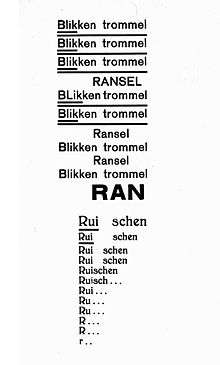
Van Doesburg wrote Dada poetry himself in De Stijl, although under a pseudonym, I.K. Bonset, which was only revealed after his death in 1931. 'Together' with I.K. Bonset, he also published a short-lived Dutch Dada magazine called Mécano (1922–3). Another Dutchman identified by K. Schippers in his study of the movement in the Netherlands[26] was the Groningen typographer H. N. Werkman, who was in touch with Van Doesburg and Schwitters while editing his own magazine, The Next Call (1923–6). Two more artists mentioned by Schippers were German-born and eventually settled in the Netherlands. These were Otto van Rees, who had taken part in the liminal exhibitions at the Café Voltaire in Zürich, and Paul Citroen.
Georgia
Although Dada itself was unknown in Georgia until at least 1920, from 1917 until 1921 a group of poets called themselves "41st Degree" (referring both to the latitude of Tbilisi, Georgia and to the temperature of a high fever) organized along Dadaist lines. The most important figure in this group was Iliazd, whose radical typographical designs visually echo the publications of the Dadaists. After his flight to Paris in 1921, he collaborated with Dadaists on publications and events.
Yugoslavia
In Yugoslavia there was heavy Dada activity between 1920 and 1922, run mainly by Dragan Aleksić and including work by Mihailo S. Petrov, Zenitist's two brothers Ljubomir Micić and Branko Ve Poljanski. Aleksić used the term "Yougo-Dada" and is known to have been in contact with Raoul Hausmann, Kurt Schwitters, and Tristan Tzara.[27]
Italy
The Dada movement in Italy, based in Mantua, was met with distaste and failed to make a significant impact in the world of art. It published a magazine for a short time and held an exhibition in Rome, featuring paintings, quotations from Tristan Tzara, and original epigrams such as "True Dada is against Dada". The most notable member of this group was Julius Evola, who went on to become an eminent scholar of occultism, as well as a right-wing philosopher and an assistant to Benito Mussolini.[28]
Tokyo
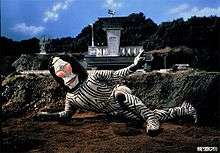
A prominent Dada group in Japan was MAVO (JA), founded in July 1923 by Tomoyoshi Murayama and Masamu Yanase (DE, JA). Other prominent artists were Jun Tsuji, Eisuke Yoshiyuki, Shinkichi Takahashi (JA) and Katsue Kitasono.
In the Tsuburaya Productions's Ultra Series, an alien named Dada was designed after the Dadaism movement, with said character first appearing in episode 28 the 1966 tokusatsu series, Ultraman made by the show's monster designer, Toru Narita. Dada's design is primarily monochromatic, and features numerous sharp lines and alternating black and white stripes, as a reference to the movement. On May 19, 2016, in celebration to the 100 year anniversary of Dadaism in Tokyo, the Ultra Monster was invited to meet the Swiss Ambassador Urs Bucher.[29][30]
Russia
The Russian literary group "Nichevoki" came close to the Dada ideologies. Members became famous for proposing that Vladimir Mayakovsky should go to the Pushkin monument at Tverskoy Boulevard and clean the shoes of anyone who asked, after he had declared that he would "clean up Russian poetry".
Poetry, music and sound
Dada was not confined to the visual and literary arts; its influence reached into sound and music. Kurt Schwitters developed what he called sound poems, while Francis Picabia and Georges Ribemont-Dessaignes composed Dada music performed at the Festival Dada in Paris on 26 May 1920. Other composers such as Erwin Schulhoff, Hans Heusser and Albert Savinio all wrote Dada music, while members of Les Six collaborated with members of the Dada movement and had their works performed at Dada gatherings. Erik Satie also dabbled with Dadaist ideas during his career, although he is primarily associated with musical Impressionism.
In the very first Dada publication, Hugo Ball describes a "balalaika orchestra playing delightful folk-songs." African music and jazz were common at Dada gatherings.
Marc Lowenthal, in I Am a Beautiful Monster: Poetry, Prose, and Provocation, writes:
Dada is the groundwork to abstract art and sound poetry, a starting point for performance art, a prelude to postmodernism, an influence on pop art, a celebration of antiart to be later embraced for anarcho-political uses in the 1960s and the movement that laid the foundation for Surrealism.[31]
Legacy
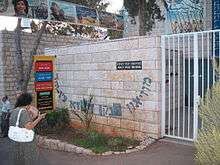
While broadly based, the movement was unstable. By 1924 in Paris, Dada was melding into surrealism, and artists had gone on to other ideas and movements, including surrealism, social realism and other forms of modernism. Some theorists argue that Dada was actually the beginning of postmodern art.[32]
By the dawn of the Second World War, many of the European Dadaists had emigrated to the United States. Some died in death camps under Adolf Hitler, who actively persecuted the kind of "degenerate art" that he considered Dada to represent. The movement became less active as post-war optimism led to the development of new movements in art and literature.
Dada is a named influence and reference of various anti-art and political and cultural movements, including the Situationist International and culture jamming groups like the Cacophony Society. Upon breaking up in July 2012, famous anarchist pop band Chumbawamba issued a statement which compared their own legacy with that of the Dada art movement.[33]
At the same time that the Zürich Dadaists were making noise and spectacle at the Cabaret Voltaire, Lenin was planning his revolutionary plans for Russia in a nearby apartment. Tom Stoppard used this coincidence as a premise for his play Travesties (1974), which includes Tzara, Lenin, and James Joyce as characters. French writer Dominique Noguez imagined Lenin as a member of the Dada group in his tongue-in-cheek Lénine Dada (1989).
The former building of the Cabaret Voltaire fell into disrepair until it was occupied from January to March 2002, by a group proclaiming themselves Neo-Dadaists, led by Mark Divo.[34] The group included Jan Thieler, Ingo Giezendanner, Aiana Calugar, Lennie Lee, and Dan Jones. After their eviction, the space was turned into a museum dedicated to the history of Dada. The work of Lee and Jones remained on the walls of the new museum.
Several notable retrospectives have examined the influence of Dada upon art and society. In 1967, a large Dada retrospective was held in Paris. In 2006, the Museum of Modern Art in New York City mounted a Dada exhibition in partnership with the National Gallery of Art in Washington D.C. and the Centre Pompidou in Paris. The LTM label has released a large number of Dada-related sound recordings, including interviews with artists such as Tzara, Picabia, Schwitters, Arp, and Huelsenbeck, and musical repertoire including Satie, Ribemont-Dessaignes, Picabia, and Nelly van Doesburg.[35]
Art techniques developed
Collage
The Dadaists imitated the techniques developed during the cubist movement through the pasting of cut pieces of paper items, but extended their art to encompass items such as transportation tickets, maps, plastic wrappers, etc. to portray aspects of life, rather than representing objects viewed as still life.
Cut-up technique
Cut-up technique is an extension of collage to words themselves, Tristan Tzara describes this in the Dada Manifesto:[36]
TO MAKE A DADAIST POEM
Take a newspaper.
Take some scissors.
Choose from this paper an article of the length you want to make your poem.
Cut out the article.
Next carefully cut out each of the words that makes up this article and put them all in a bag.
Shake gently.
Next take out each cutting one after the other.
Copy conscientiously in the order in which they left the bag.
The poem will resemble you.
And there you are – an infinitely original author of charming sensibility, even though unappreciated by the vulgar herd.
Photomontage
The Dadaists – the "monteurs" (mechanics) – used scissors and glue rather than paintbrushes and paints to express their views of modern life through images presented by the media. A variation on the collage technique, photomontage utilized actual or reproductions of real photographs printed in the press. In Cologne, Max Ernst used images from the First World War to illustrate messages of the destruction of war.[37]
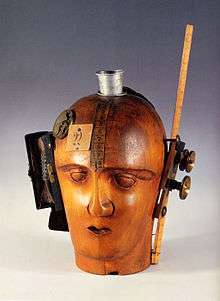
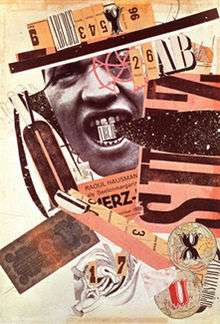
Assemblage
The assemblages were three-dimensional variations of the collage – the assembly of everyday objects to produce meaningful or meaningless (relative to the war) pieces of work including war objects and trash. Objects were nailed, screwed or fastened together in different fashions. Assemblages could be seen in the round or could be hung on a wall.[38]
Readymades
Marcel Duchamp began to view the manufactured objects of his collection as objects of art, which he called "readymades". He would add signatures and titles to some, converting them into artwork that he called "readymade aided" or "rectified readymades". Duchamp wrote: "One important characteristic was the short sentence which I occasionally inscribed on the 'readymade.' That sentence, instead of describing the object like a title, was meant to carry the mind of the spectator towards other regions more verbal. Sometimes I would add a graphic detail of presentation which in order to satisfy my craving for alliterations, would be called 'readymade aided.'"[39] One such example of Duchamp's readymade works is the urinal that was turned onto its back, signed "R. Mutt", titled "Fountain", and submitted to the Society of Independent Artists exhibition that year. The piece was not displayed during the show, a fact that unmasked the inherently biased system that was the art establishment, seeing as any artist that paid the entry fee could in theory display their art, but the work of R. Mutt was banished by the judgment of a group of artists.[13]
Artists
- Louis Aragon (1897–1982), France
- Jean Arp (1886–1966), Germany, France
- Hugo Ball (1886–1927), Germany, Switzerland
- André Breton (1896–1966), France
- Otto Dix (1891–1969), Germany
- Theo van Doesburg (1883–1931) Netherlands
- Marcel Duchamp (1887–1968), France
- Paul Éluard (1895–1952), France
- Max Ernst (1891–1976), Germany, USA
- Julius Evola (1898–1974), Italy
- George Grosz (1893–1959), Germany, France, USA
- Raoul Hausmann (1886–1971), Germany
- John Heartfield (1891–1968), Germany, USSR, Czechoslovakia, Great Britain
- Hannah Höch (1889–1978), Germany
- Richard Huelsenbeck (1892–1974), Germany
- Marcel Janco (1895–1984), Romania, Israel
- Elsa von Freytag-Loringhoven (1874–1927), Germany, USA
- Clément Pansaers (1885–1922), Belgium
- Francis Picabia (1879–1953), France
- Man Ray (1890–1976), France, USA
- Georges Ribemont-Dessaignes (1884–1974), France
- Kurt Schwitters (1887–1948), Germany
- Walter Serner (1889–1942), Austria
- Philippe Soupault (1897–1990), France
- Sophie Taeuber-Arp (1889–1943), Switzerland, France
- Tristan Tzara (1896–1963), Romania, France
- Beatrice Wood (1893–1998), USA
See also
References
- ↑ Mario de Micheli (2006). Las vanguardias artísticas del siglo XX. Alianza Forma. p.135-137
- ↑ Anti-art, Art that challenges the existing accepted definitions of art, Tate
- ↑ Dada, Tate
- ↑ Roselee Goldberg, Thomas & Hudson, L'univers de l'art, Chapter 4, Le surréalisme, Les représentations pré-Dada à Paris, ISBN 978-2-87811-380-8
- ↑ Dawn Ades, Early History: Zurich, 1914–18, MoMA, Grove Art Online, Oxford University Press, 2009
- ↑ Dawn Ades, Barcelona and developments in Zurich, 1916–20, MoMA, Grove Art Online, Oxford University Press, 2009
- 1 2 Richter, Hans (1965), Dada: Art and Anti-art, New York and Toronto: Oxford University Press
- 1 2 Schneede, Uwe M. (1979), George Grosz, His life and work, New York: Universe Books
- 1 2 Budd, Dona, The Language of Art Knowledge, Pomegranate Communications, Inc.
- ↑ DADA: Cities, National Gallery of Art, retrieved 2008-10-19
- 1 2 Fred S. Kleiner (2006), Gardner's Art Through the Ages (12th ed.), Wadsworth Publishing, p. 754
- ↑ Tom Sandqvist, DADA EAST: The Romanians of Cabaret Voltaire, London MIT Press, 2006.
- 1 2 "Introduction: "Everybody can Dada"". National Gallery of Art. Retrieved 10 May 2012.
- ↑ Marcel Janco, "Dada at Two Speeds," trans. in Lucy R. Lippard, Dadas on Art (Englewood Cliffs, N.J., 1971), p. 36.
- ↑ "Cabaret Voltaire". DADA Companion. Retrieved 2011-06-11.
- ↑ Europe of Cultures. "Tristan Tzara speaks of the Dada Movement.", September 6, 1963. Retrieved on July 2, 2015.
- ↑ Naumann, Francis M. (1994). New York Dada. New York: Abrams. ISBN 0810936763.
- 1 2 Dada, Dickermann, National Gallery of Art, Washington, 2006 p443
- ↑ Dada, Dickermann, National Gallery of Art, Washington, 2006 p99
- ↑ Schaefer, Robert A. (September 7, 2006), "Das Ist Dada–An Exhibition at the Museum of Modern Art in NYC", Double Exposure
- ↑ http://www.independent.co.uk/news/uk/this-britain/fountain-most-influential-piece-of-modern-art-673625.html, Independent, December 2, 2004
- ↑ "Duchamp's urinal tops art survey", BBC News December 1, 2004.
- ↑ Duchamp, Marcel trans. and qtd. in Gammel, Irene. Baroness Elsa: Gender, Dada and Everyday Modernity. Cambridge, MA: MIT Press, 2002, 224.
- ↑ Gammel, Baroness Elsa, 224–225.
- ↑ Marc Dachy, Dada, la révolte de l'art, Paris, Gallimard / Centre Pompidou, "Découvertes" n° 476 , 2005.
- ↑ Holland Dada, Amsterdam, 1974
- ↑ Jovanov Jasna, Kujundžić Dragan, "Yougo-Dada". "Crisis and the Arts: The History of Dada", Vol. IV, The Eastern Orbit: Russia, Georgia, Ukraine, Central Europe and Japan, General Editor Stephen C. Foster, G.K. Hall & Comp. Publishers, New York 1998, 41–62; Jasna Jovanov,Demistifikacija apokrifa: dadaizam na jugoslovenskim prostorima 1920–1922, Novi Sad: Apokrif, 1999.
- ↑ Julius Evola – International Dada Archive
- ↑ "「三面怪人 ダダ」が「ダダイズム100周年」を祝福!スイス大使館で開催された記者発表会に登場!" (in Japanese). m-78.jp. 2016-05-19. Retrieved 2016-06-08.
- ↑ "Dada Celebrates Dadaism's 100th Anniversary". tokusatsunetwork.com. 2016-05-19. Retrieved 2016-06-08.
- ↑ Marc Lowenthal, translator's introduction to Francis Picabia's I Am a Beautiful Monster: Poetry, Prose, and Provocation
- ↑ Locher, David (1999), "Unacknowledged Roots and Blatant Imitation: Postmodernism and the Dada Movement", Electronic Journal of Sociology, 4 (1), retrieved 2007-04-25
- ↑ "Chumbawamba". Retrieved 10 July 2012.
- ↑ 2002 occupation by neo-Dadaists Prague Post
- ↑ LTM Recordings
- ↑ "manifestos: dada manifesto on feeble love and bitter love by tristan tzara, 12th december 1920". 391. 1920-12-12. Retrieved 2011-06-27.
 This article incorporates text from this source, which is in the public domain.
This article incorporates text from this source, which is in the public domain. - ↑ "DADA – Techniques – photomontage". Nga.gov. Retrieved 2011-06-11.
- ↑ "DADA – Techniques – assemblage". Nga.gov. Retrieved 2011-06-11.
- ↑ "The Writings of Marcel Duchamp" ISBN 0-306-80341-0
Bibliography
- The Dada Almanac, ed Richard Huelsenbeck [1920], re-edited and translated by Malcolm Green et al., Atlas Press, with texts by Hans Arp, Johannes Baader, Hugo Ball, Paul Citröen, Paul Dermée, Daimonides, Max Goth, John Heartfield, Raoul Hausmann, Richard Huelsenbeck, Vincente Huidobro, Mario D'Arezzo, Adon Lacroix, Walter Mehring, Francis Picabia, Georges Ribemont-Dessaignes, Alexander Sesqui, Philippe Soupault, Tristan Tzara. ISBN 0-947757-62-7
- Blago Bung, Blago Bung, Hugo Ball's Tenderenda, Richard Huelsenbeck's Fantastic Prayers, & Walter Serner's Last Loosening – three key texts of Zurich ur-Dada. Translated and introduced by Malcolm Green. Atlas Press, ISBN 0-947757-86-4
- Ball, Hugo. Flight Out Of Time (University of California Press: Berkeley and Los Angeles, 1996)
- Jones, Dafydd W. Dada 1916 In Theory: Practices of Critical Resistance (Liverpool: Liverpool University Press, 2014). ISBN 978-1-781-380-208
- Biro, M. The Dada Cyborg: Visions of the New Human in Weimar Berlin. Minneapolis: University of Minnesota Press, 2009. ISBN 0-8166-3620-6
- Dachy, Marc. Journal du mouvement Dada 1915–1923, Genève, Albert Skira, 1989 (Grand Prix du Livre d'Art, 1990)
- Dada & les dadaïsmes, Paris, Gallimard, Folio Essais, n° 257, 1994.
- Jovanov, Jasna. Demistifikacija apokrifa: Dadaizam na jugoslovenskim prostorima, Novi Sad/Apostrof 1999.
- Dada, la révolte de l'art, Paris, Gallimard / Centre Pompidou, Découvertes n° 476, 2005.
- Archives Dada / Chronique, Paris, Hazan, 2005.
- Dada, catalogue d'exposition, Centre Pompidou, 2005.
- Durozoi, Gérard. Dada et les arts rebelles, Paris, Hazan, Guide des Arts, 2005
- Gammel, Irene. Baroness Elsa: Gender, Dada and Everyday Modernity. Cambridge, MA: MIT Press, 2002.
- Hoffman, Irene. Documents of Dada and Surrealism: Dada and Surrealist Journals in the Mary Reynolds Collection, Ryerson and Burnham Libraries, The Art Institute of Chicago.
- Huelsenbeck, Richard. Memoirs of a Dada Drummer, (University of California Press: Berkeley and Los Angeles, 1991)
- Jones, Dafydd. Dada Culture (New York and Amsterdam: Rodopi Verlag, 2006)
- Lavin, Maud. Cut With the Kitchen Knife: The Weimar Photomontages of Hannah Höch. New Haven: Yale University Press, 1993.
- Lemoine, Serge. Dada, Paris, Hazan, coll. L'Essentiel.
- Lista, Giovanni. Dada libertin & libertaire, Paris, L'insolite, 2005.
- Melzer, Annabelle. 1976. Dada and Surrealist Performance. PAJ Books ser. Baltimore and London: The Johns Hopkins UP, 1994. ISBN 0-8018-4845-8.
- Novero, Cecilia. "Antidiets of the Avant-Garde: From Futurist Cooking to Eat Art." (University of Minnesota Press, 2010)
- Richter, Hans. Dada: Art and Anti-Art (London: Thames and Hudson, 1965)
- Sanouillet, Michel. Dada à Paris, Paris, Jean-Jacques Pauvert, 1965, Flammarion, 1993, CNRS, 2005
- Sanouillet, Michel. Dada in Paris, Cambridge, Massachusetts, The MIT Press, 2009
- Schippers, K. Holland Dada, Amsterdam, Em. Querido, 1974
- Schneede, Uwe M. George Grosz, His life and work (New York: Universe Books, 1979)
- Verdier, Aurélie. L'ABCdaire de Dada, Paris, Flammarion, 2005.
External links
| Library resources about Dada |
| Wikiquote has quotations related to: Dada |
| Wikimedia Commons has media related to Dada. |
- Dada Companion, bibliographies, chronology, artists' profiles, places, techniques, reception
- Dada at DMOZ
- Dada, Encyclopædia Britannica
- Dada art
- The International Dada Archive, University of Iowa, early Dada periodicals, online scans of publications
- Dadart, history, bibliography, documents, and news
- From Dada to Surrealism, review from The Guardian
- Dada audio recordings at LTM
- New York dada (magazine), Marcel Duchamp and Man Ray, April, 1921, Bibliothèque Kandinsky, Centre Pompidou (access online)
Manifestos
- Text of Hugo Ball's 1916 Dada Manifesto
- Text of Tristan Tzara's 1918 Dada Manifesto
- Excerpts of Tristan Tzara's Dada Manifesto (1918) and Lecture on Dada (1922)
